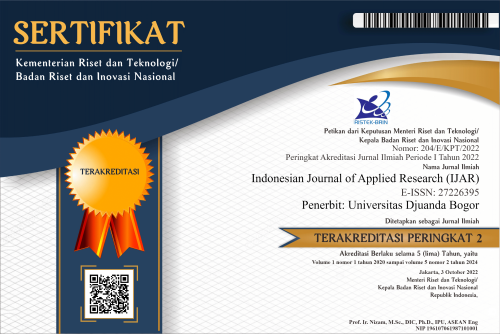Development of a Simple Micriscope from Used Goods as a Science Learning Media
Abstract
The purpose of this study is expected to be able to develop a microscope from used goods that are used as a mechanism for learning science in schools. By using a simple microscope from used goods, it can make it easier for educators and students in the teaching and learning process. Furthermore, this research also has a stage in the manufacturing process or called the method. The method used is called the 4D development method, where this method has the stages of Define, Design, Develop, and Disseminate. According to the results of the research conducted, a simple microscope from used goods is very effective as a learning medium. A simple microscope from scrap can also ease the burden on the school in purchasing a microscope due to the high price of a microscope. The results obtained were quite good and in accordance with the cellphone camera at the time the study was carried out. Despite this, this simple microscope has its advantages and disadvantages. The advantage of this simple microscope is that this microscope is made of materials around us so that students themselves have no difficulty making it. While the weakness lies in this simple microscope which can only see objects with a magnification of 10 times the original and the quality is then in accordance with the cellphone camera used.
References
Ariska, M. (2018). ANALISIS MOMEN INERSIA TIPPE TOP DI BIDANG DATAR SEBAGAI KONTRIBUSI PADA MATA KULIAH MEKANIKA. JIPF (Jurnal Inovasi Dan Pembelajaran Fisika), 5(2), 181–187.
Ariska, M., & Alawiyah, S. (2019). Mikroskop Digital Berbasis Kamera Smartphone. JIPFRI (Jurnal Inovasi Pendidikan Fisika Dan Riset Ilmiah), 3(2), 108–112. https://doi.org/10.30599/jipfri.v3i2.455
Handayani, S. (2019). Penerapan Mikroskop Digital dengan Bantuan Smartphone Android sebagai Media Pembelajaran IPA. SAP (Susunan Artikel Pendidikan), 4(1). https://doi.org/10.30998/sap.v4i1.3611
Arianti, E. (2014). Mikroskop Sederhana Dari Botol Plastik Sebagai Alat Pembelajaran Pada Pengamatan Sel. Jurnal EduBio Tropika, 2(2), 187–250.
Ariska, M. (2018). ANALISIS MOMEN INERSIA TIPPE TOP DI BIDANG DATAR SEBAGAI KONTRIBUSI PADA MATA KULIAH MEKANIKA. JIPF (Jurnal Inovasi Dan Pembelajaran Fisika), 5(2), 181–187.
Ariska, M., & Alawiyah, S. (2019). Mikroskop Digital Berbasis Kamera Smartphone. JIPFRI (Jurnal Inovasi Pendidikan Fisika Dan Riset Ilmiah), 3(2), 108–112. https://doi.org/10.30599/jipfri.v3i2.455
Handayani, S. (2019). Penerapan Mikroskop Digital dengan Bantuan Smartphone Android sebagai Media Pembelajaran IPA. SAP (Susunan Artikel Pendidikan), 4(1). https://doi.org/10.30998/sap.v4i1.3611
Hartanti, I., Raharjo, & Purnomo, T. (2017). Proses Sains Dan Pemahaman Konsep Materi. Pendidikan Sains Pascasarjana Universitas Negeri Surabaya, 7(1), 1397–1408. https://doi.org/10.26740/jpps.v7n1.p1397-1408
Imamah, N. (2012). Peningkatan Hasil Belajar IPA Melalui Pembelajaran Kooperatif Berbasis Konstruktivisme Dipadukan dengan Video Animasi Materi Sistem Kehidupan Tumbuhan. Jurnal Pendidikan IPA Indonesia. Jurnal Pendidikan IPA Indonesia, 1(1), 32–36. https://doi.org/https://doi.org/10.15294/jpii.v1i1.2010
Nurseto, T. (2011). Membuat Media Pembelajaran yang Menarik. Jurnal Ekonomi & Pendidikan, 8(1), 19–35. https://doi.org/10.21831/jep.v8i1.706
Rusnilawati, R. (2016). Pengembangan perangkat pembelajaran matematika bercirikan active knowledge sharing dengan pendekatan saintifik kelas VIII. Jurnal Riset Pendidikan Matematika, 3(2), 245–258. https://doi.org/10.21831/jrpm.v3i2.10633
Shah, S. F., Khan, I. U., Khan, D., & Khan, M. F. (2013). The Impact of Physical Facilities on Quality of Primary Education in Khyber Pakhtunkhwa as Perceived by Teachers Related papers. IOSR Journal Of Humanities And Social Science (IOSR-JHSS), 18(3), 20–24. www.iosrjournals.org
Tri Cahyono, W., Cahyo, Y. S., & Winarto, S. (2018). Studi Efisiensi Pemberian Air Irigasi Pada Desa Grompol, Kecamatan Gampengrejo, Kabupaten Kediri. Jurmateks, 1(1), 12–21. https://doi.org/10.30737/jurmateks.v1i1.137
Copyright (c) 2022 Indonesian Journal of Applied Research (IJAR)

This work is licensed under a Creative Commons Attribution-ShareAlike 4.0 International License.
The Authors submitting a manuscript do so on the understanding that if accepted for publication, copyright publishing of the article shall be assigned/transferred to Indonesian Journal of Applied Research (IJAR) Universitas Djuanda as Publisher of the journal. Upon acceptance of an article, authors will be asked to complete a 'Copyright Transfer Agreement'. An e-mail will be sent to the corresponding author confirming receipt of the manuscript together with a 'Copyright Transfer Agreement' form by online version of this agreement.
Indonesian Journal of Applied Research (IJAR) Universitas Djuanda, the Editors and the Editorial Board make every effort to ensure that no wrong or misleading data, opinions or statements be published in the journal. In any way, the contents of the articles and advertisements published in the Indonesian Journal of Applied Research (IJAR) Universitas Djuanda are sole and exclusive responsibility of their respective authors and advertisers.
Remember, even though we ask for a transfer of copyright, our journal authors retain (or are granted back) significant scholarly rights as mention before.
The Copyright Transfer Agreement (CTA) Form can be downloaded here: Copyright Transfer Agreement-IJAR 2020
The copyright form should be signed electronically and send to the Editorial Office e-mail below:
Prof. Dr. Ir. Dede Kardaya, M.Si. (Editor-in-Chief)
Universitas Djuanda
Jl. Tol Jagorawi No.1, Ciawi, Kec. Ciawi, Bogor, Jawa Barat 16720
Website: http://journal.unida.ac.id/index.php/IJAR/index
Email: ijar@unida.ac.id






 This work is licensed under a
This work is licensed under a 